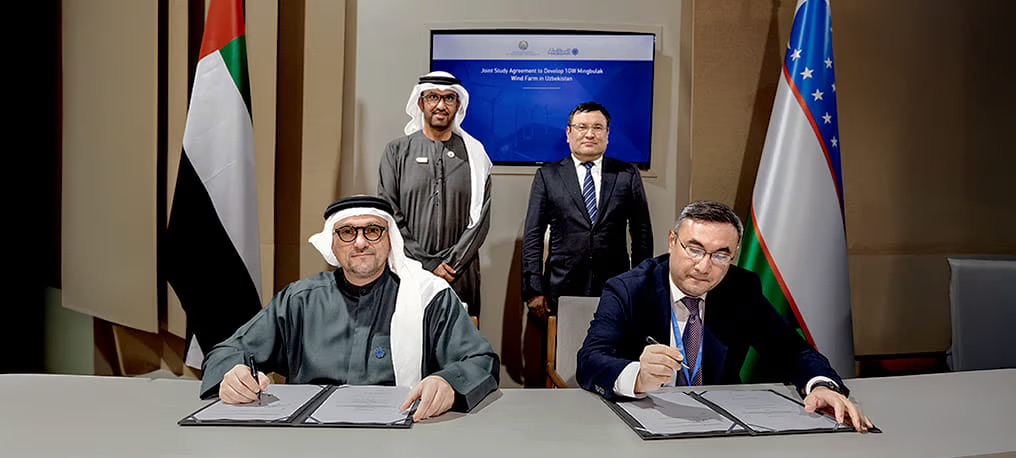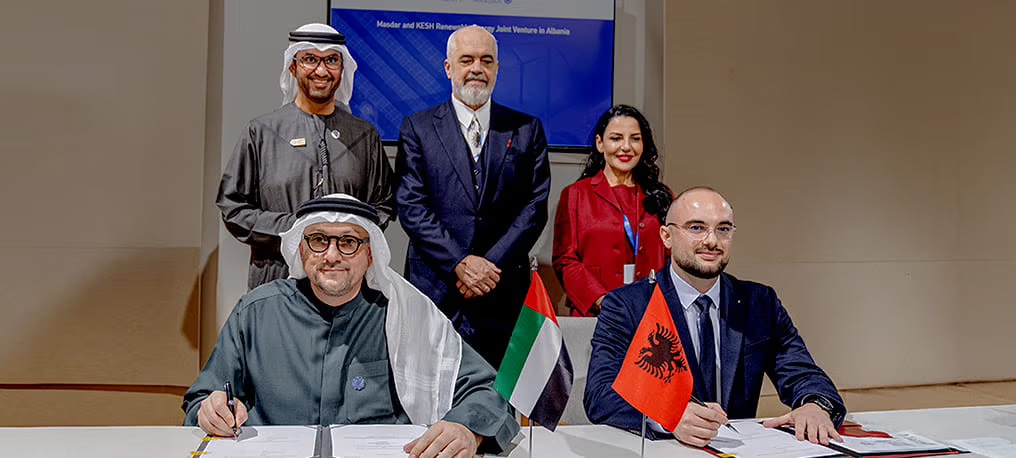
Sign up for daily news updates from CleanTechnica on email. Or follow us on Google News!
UAE clean energy giant Masdar is on a big clean power investment streak. It has announced more clean energy project progress this month than most companies in the field announce in a year. Hold onto your hats, this is going to be a big news update.
Belt & Road Initiative (BRI) Countries: Masdar is partnering with China’s Silk Road Fund (SRF) to co-invest in clean energy projects across BRI countries, especially in the developing world and global south. It’s just a Memorandum of Understanding (MoU) for now, but SRF plans to invest RMB 20 billion (~$2.8 billion) into these joint projects.
“Masdar has significant investments in the Middle East, Central Asia, Southeast Asia and Africa, many of which are participants in the Belt and Road Initiative. The company will continue to invest in these regions as part of its strategy to reach 100GW renewable energy capacity by 2030,” Masdar writes. “The UAE has been an active partner in the BRI since the initiative was launched and has already invested $10 billion in a joint China-UAE investment fund to support BRI projects in East Africa.”
Azerbaijan: Masdar and SOCAR Green secured financing for the 445 MW Bilasuvar solar project and 315 MW Neftchala solar project in Azerbaijan, both of which are expected to be completed in the first quarter of 2027.
“Masdar is dedicated to supporting Azerbaijan’s energy transition. It has signed agreements to develop onshore wind and solar projects and integrated offshore wind and green hydrogen projects with a total combined capacity of 10GW. Its first project in Azerbaijan, the 230MW Garadagh solar plant, was inaugurated in October last year,” Masdar writes.
Azerbaijan (again): Switching over to the wind industry, Masdar has again signed an agreement, an MoU, with SOCAR Green, as well as with Saudi Arabia’s ACWA Power. The plan, overall, is “to develop 3.5 gigawatts (GW) of offshore wind projects in the Azerbaijan section of the Caspian Sea,” Masdar writes.
“Under the agreement, the signing parties will follow a Corporation Roadmap to identify key development milestones they want to achieve in the development of offshore wind in the country.”
Kazakhstan: Masdar is going to build a 1 gigawatt (GW) wind power project in Kazakhstan’s Jambyl region. The wind farm will also come with a 600-megawatt-hour (MWh) battery energy storage system. A week and a half ago, Masdar signed a Power Purchase Agreement (PPA) with the Financial Settlement Centre for Renewable Energy Sources Support LLP. This is Masdar’s first project in Kazakhstan. Construction is supposed to begin in the first quarter of 2026.
“When completed, it will provide power to approximately 300,000 homes in the south of Kazakhstan, avoiding 2 million tonnes of CO2e emissions per year,” Masdar writes. “Masdar is the lead developer for the 1GW project, along with W Solar, Qazaq Green Power (a Samruk-Kazyna Group company), and the Kazakhstan Investment Development Fund.”
Masdar had reported just a few days before that it had “reached a significant milestone in the development of their 1GW windfarm in Kazakhstan, with the signing of the project’s Investment Agreement.”
Uzbekistan: Masdar signed an agreement with the Ministry of Energy Uzbekistan to build a 1 GW wind farm in the country, in the Mingbulak region. The giant wind farm project is expected to create 1,000 jobs during construction and 60 jobs during operation, and it is expected to produce clean electricity for 300,000 homes.
Overall, long term, Masdar intends to develop three wind farms in Uzbekistan totaling at least 2 GW of power capacity. “The new wind project will contribute to Uzbekistan’s growing renewable energy portfolio and complement Masdar’s existing projects in the country, which include six utility-scale solar power plants. These initiatives are designed to enhance energy security, create jobs, and drive sustainable economic growth in Uzbekistan, while significantly reducing greenhouse gas emissions. This aligns with Masdar’s commitment to support Uzbekistan’s goal of generating 40 percent of the country’s electricity from renewable sources by 2030,” Masdar writes. “Masdar has been an early mover in Uzbekistan’s renewable energy market, with landmark projects that include the 500MW Zarafshan Wind Farm, that will provide enough electricity to power more than 150,000 homes when fully operational. Masdar also developed the 100MW utility-scale Nur Navoi photovoltaic (PV) solar plant, which has been operational since 2021.”
Albania: This one is less nailed down, but, clearly, Albania likes what it’s been seeing. Masdar and Korporata Elektroenergjitike Shqiptare (KESH) – Albania Power Corporation “signed a joint venture term sheet agreement to explore the development of gigawatt-scale renewable projects in Albania.”
“The joint venture term sheet agreement aims to develop, construct, and operate renewable energy projects utilizing a range of renewable technologies, including solar PV, wind, and hybrid solutions, with potential integration of battery storage. The energy produced is expected to be supplied to the Albanian market and exported to neighboring countries,” Masdar writes.
Malaysia: One final project announcement from this month (for now) is a floating solar power plant in Malaysia. Along with Sarawak Energy and Gentari, Masdar signed a “Joint Study Agreement” in order to “assess the feasibility of a floating solar power plant at the reservoir of Murum Hydroelectric Plant in the state of Sarawak, Malaysia.”
This would be Masdar’s second floating solar PV project, following a 145 MW solar power plant in Cirata, Indonesia. “Floating solar projects offer several advantages for countries like Malaysia with growing populations and a scarcity of land that is required for agriculture, housing and industry. Placing solar plants on water reduces land use, decreases water evaporation, and offers potential synergies with hydroelectric operations,” Masdar notes.
Bonus in Uzbekistan: This one isn’t about a new or potential project. Rather, the news here is that the company is using AI to protect birds of prey at the 500 MW Zarafshan wind farm in Uzbekistan. Confused? I was too. Here’s the summary: “In the largest implementation of AI into biodiversity protection at a wind farm anywhere in the world, Masdar has deployed Identiflight technology to detect birds of prey flying in the area around the wind turbines.
“The system sends a signal to the operation centre to shut the wind turbine down if a bird is flying in the area and there is a risk of collision. Once the bird has left the area, it turns the turbine back on.” Cool.

Chip in a few dollars a month to help support independent cleantech coverage that helps to accelerate the cleantech revolution!
Have a tip for CleanTechnica? Want to advertise? Want to suggest a guest for our CleanTech Talk podcast? Contact us here.
Sign up for our daily newsletter for 15 new cleantech stories a day. Or sign up for our weekly one if daily is too frequent.
CleanTechnica uses affiliate links. See our policy here.
CleanTechnica’s Comment Policy










